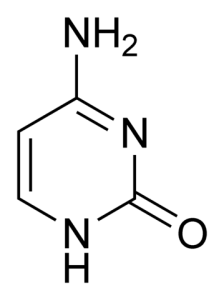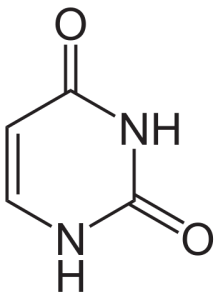RNA: Basic Knowledge
Table of Contents
Image : “Pre-mRNA-1ysv-tubes” by Vossman. License: CC BY-SA 3.0
Definition and Background
The three major molecules that are essential for all known forms of life are RNA, DNA and proteins. DNA and RNA have a similar chemical structure with two main differences:
- The sugar ribose is found in RNA; however, DNA contains the sugar deoxyribose, which is slightly different than ribose, in that it lacks an oxygen atom.
- DNA has the nucleobase thymine; whereas, RNA contains uracil. Thymine and uracil have similar base-pairing properties.

Image: “Formation of an RNA strand from a DNA template” by Fred the Oyster. License: CC BY-SA 3.0
Types of RNA
Messenger RNA (mRNA)
Messenger RNA (mRNA) is transcribed from a DNA template. Coding information to the sites of the ribosomes is carried through mRNA. In mRNA, the genetic information is encoded in the sequence of nucleotides, which is arranged into codons that consist of three bases each. A specific amino acid is encoded by each one of the codons, except the stop codons, which are responsible for terminating the process of protein synthesis. Two other types of RNA are required in this process, which are ribosomal RNA (rRNA) and transfer RNA (tRNA).
The structure of a mature eukaryotic mRNA. A fully processed mRNA includes a 5′ cap, 5′ UTR, coding region, 3′ UTR and poly(A) tail.
Ribosomal RNA (rRNA)
Image: “Structure and shape of the E.coli 70S ribosome. The large 50S ribosomal subunit (red) and small 30S ribosomal subunit (blue) are shown with a 200 Ångstrom (20 nm) scale bar. For the 50S subunit, the 23S (dark red) and 5S (orange red) rRNAs and the ribosomal proteins (pink) are shown. For the 30S subunit, the 16S rRNA (dark blue) and the ribosomal proteins (light blue) are shown.” by Vossman. License: CC BY-SA 3.0
Ribosomal RNA (rRNA) is the RNA component of the ribosome. The mechanism for decoding mRNA into amino acids is provided by ribosomal RNA, it also interacts with tRNAs during translation and provides peptidyl transferase activity. The necessary amino acids that correspond to the appropriate mRNA codon are brought by the tRNAs.
Transfer RNA (tRNA)
Image: “The Interaction of tRNA and mRNA in Protein Synthesis.” by Boumphreyfr. License: CC BY-SA 3.0
Transfer RNA (tRNA) functions in the transfer of specific active amino acids, during translation, to a growing polypeptide chain at the ribosomal site of protein synthesis. Transfer RNA contains the anticodon, which is a three base region and can base pair to the corresponding three base codon regions on mRNA. Only one type of amino acid can be attached to each type of tRNA molecule; however, the same amino acid may be carried by tRNA molecules bearing different anticodons because multiple codons that specify the same amino acid are found in the genetic code.
Image: “Tertiary structure of tRNA. CCA tail in yellow, Acceptor stem in purple, Variable loop in orange, D arm in red, Anticodon arm in blue with Anticodon in black and T arm in green.” by Yikrazuul. License: CC BY-SA 3.0
Other Types of RNA
Small interfering RNA (siRNA)
Small interfering RNA (siRNA) is also known as short interfering RNA, which is a class of double-stranded RNA molecule. siRNA is involved in the RNA interference pathway. It controls the stability of the mRNA by interfering with the expression of specific genes.
Small nuclear RNA (snRNA)
snRNA molecules are either transcribed by RNA polymerase III along with all nuclear tRNAs and the 5S rRNA, or by RNA polymerase II along with mRNA. They are involved in the maintenance of the telomeres and splicing by removal of introns from pre-mRNA.
Heterogeneous nuclear RNA (hnRNA)
hnRNA is considered a single immature strand of mRNA. The two terms pre-mRNA and hnRNAare almost identical, and they are used interchangeably.
RNA Nucleobases
Image: “Chemical Structure of Adenine in Vector Format” by Pepemonbu. License: CC BY-SA 3.0
Adenine (A)
Adenine is a purine derivative nucleobase with different roles in biochemistry, including cellular respiration, in the form ofATP, NAD and FAD. It also plays a role as a chemical component of DNA and RNA in protein synthesis. Adenine has a shape that is complementary to either uracil in RNA or thymine in DNA.
Cytosine (C)
Cytosine is found in both DNA and RNA, which is a pyrimidine derivative. It has a heterocyclic aromatic ring and two substituents attached which are a keto group at position 2, and an amine group at position 4). Cytidine is the nucleoside of cytosine.
Image: “Chemical Structure of Cytosine.” by Cacycle. License: CC BY-SA 3.0
Guanine (G)
Guanine is found in both RNA and DNA. It is a derivative of purine and consists of a fused pyrimidine-imidazole ring system, along with conjugated double bonds. Guanine is paired with cytosine in DNA.
Uracil (U)
Uracil is a demethylated form of thymine, and it binds to adenine, via two hydrogen bonds, in RNA. In DNA, thymine nucleobases replace uracil.
Differences between DNA and RNA
Both DNA and RNA are very similar in their structures; however, there are five main differences between them both:
Image: “Comparison of a Single-Stranded RNA and a Double-Stranded DNA with their Corresponding Nucleobases” by Sponk. License: CC BY-SA 3.0
Collagen
Background
- From greek “kolla” (glue) “gen” (producing)
- Boiling hooves to make glue
- Gelatin — collagen that has been irreversibly hydrolyzed
- Medical uses in treating bones and skin
- Most abundant protein in body
- 25—30 % of all body protein by weight
- Synthesis decreases with age
- 29 types in the body
- Over 90 % of the collagen in the human body is type I
- Most common types — I, II, III, IV, V
- Type I collagen fibrils are stronger by weight than steel
- Basement membrane of extracellular matrix
- Blood vessel damage exposes collagen — signal to clotting system
States of collagen
- State of collagen depends on mineralization
- Bone, tendon, cartilage
- Fibrillar and non-fibrillar types
- Most abundant fibrous tissue — ligaments, tendons, skin
Structure
- Triple helix of helices
- Each polypeptide chain up to about 1,400 amino acids
- Type 1 collagen contains two identical α-1 chains and one α-2 chain
- Each chain is a left-handed helix
- Three chains coiled together to make right-handed strand (superhelix)
- Strands combined together to make fibers
Biochemistry of collagen
- Strands synthesized into endoplasmic reticulum (ER)
- Hydroxylation of prolines and lysines occurs in ER
- Hydroxylation necessary for collagen secretion
- Secreted collagen strands form helix
- Helices cross-link for strength
Clinical biochemistry
- Proline hydroxylation
- Requires vitamin C
- Deficiency leads to scurvy
- Crusaders of 13th century suffered from scurvy
- Value of citrus fruits for preventing scurvy known by Vasco de Gama´s voyage of 1497
- Nonetheless, over 2 million sailors died of scurvy between 1500 and 1800
- Proline hydroxylation increases collagen´s thermal stability
- Stabilizes collagen at body temperature
- Cooking hydrolyzed collagen — tenderizing
Lysyl oxidase
- Extracellular enzyme
- Oxidizes lysines/ hydroxylysines to aldehydes in extracellular matrix
 Collagen crosslinking
Collagen crosslinking
- Aldehydes of allysine can react with amines of other lysines to form pyridinoline
- This cross-linking gives collagen its strength
Disease & Collagen
Review Questions
The answers are below the references.
1. All of the following are types of RNA except:
- Messenger RNA (mRNA)
- Transfer RNA (tRNA)
- Ribosomal RNA (rRNA)
- Nuclear RNA (nRNA)
2. In a protein, each amino acid is specified by:
- A promoter
- A codon
- Several genes
- An mRNA molecule
3. RNA and DNA have the same nucleobases, except that RNA contains:
- Cytosine instead of guanine
- Cysteine instead of cytosine
- Uracil instead of adenine
- Uracil instead of thymine











Este comentário foi removido por um gestor do blogue.
ResponderEliminar